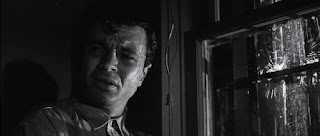 Cinematographer, Conrad Hall said: “Manipulating shadows and tonality is like writing music or a poem.” Conrad Hall shot “In Cold Blood” (1967) so I think we should listen to him. I have always loved films that feature great black and white cinematography. The beauty resides just as much in what remains hidden as in what is shown. So this week, I decided to showcase a double feature of films that don’t just use shadows for tone or atmosphere. In the case of these films, much of the story is actually told in the shadows.
Cinematographer, Conrad Hall said: “Manipulating shadows and tonality is like writing music or a poem.” Conrad Hall shot “In Cold Blood” (1967) so I think we should listen to him. I have always loved films that feature great black and white cinematography. The beauty resides just as much in what remains hidden as in what is shown. So this week, I decided to showcase a double feature of films that don’t just use shadows for tone or atmosphere. In the case of these films, much of the story is actually told in the shadows.  I wouldn’t say that Carl Theodor Dreyer was a filmmaker that was ahead of his time 80+ years ago. I am more inclined to say that 80+ years ago, Carl Theodor Dreyer was a filmmaker that was ahead of our time now. His “Vampyr” (1932) is only one example of his technical and artistic genius. It was his first ‘talkie’ and he used dialogue sparingly. What he used brilliantly however was light and shadows. This was a time when special effects were actually special. Everything was done practically and much of it was actually shot outside. This was his first film after my favorite silent film, “The Passion of Joan of Arc” (1928) and the last film he would direct for ten years.
I wouldn’t say that Carl Theodor Dreyer was a filmmaker that was ahead of his time 80+ years ago. I am more inclined to say that 80+ years ago, Carl Theodor Dreyer was a filmmaker that was ahead of our time now. His “Vampyr” (1932) is only one example of his technical and artistic genius. It was his first ‘talkie’ and he used dialogue sparingly. What he used brilliantly however was light and shadows. This was a time when special effects were actually special. Everything was done practically and much of it was actually shot outside. This was his first film after my favorite silent film, “The Passion of Joan of Arc” (1928) and the last film he would direct for ten years.
 Our next film is Carol Reed’s “The Third Man” (1950). Written by Graham Green and photographed beautifully by Robert Krasker. Joseph Cotten plays Holly Martins, an American arriving in Vienna to work for his longtime friend Harry Lime (Orson Welles). He arrives just in time to find that his host has died and nobody seems to know how or why. The story of his friend’s checkered past unfolds as he searches through the underbelly of the city, revealing more questions than answers. The shadow play aspect of this film is at 11, culminating with a foot chase through a lantern lit sewer. This is one of those films that made me start looking at black and white cinematography differently. This film is all about the unknown and it quite frankly would never have worked without the dark corners and dim crevices and what may or may not be lurking in the shadows.
Our next film is Carol Reed’s “The Third Man” (1950). Written by Graham Green and photographed beautifully by Robert Krasker. Joseph Cotten plays Holly Martins, an American arriving in Vienna to work for his longtime friend Harry Lime (Orson Welles). He arrives just in time to find that his host has died and nobody seems to know how or why. The story of his friend’s checkered past unfolds as he searches through the underbelly of the city, revealing more questions than answers. The shadow play aspect of this film is at 11, culminating with a foot chase through a lantern lit sewer. This is one of those films that made me start looking at black and white cinematography differently. This film is all about the unknown and it quite frankly would never have worked without the dark corners and dim crevices and what may or may not be lurking in the shadows.
Enjoy.






